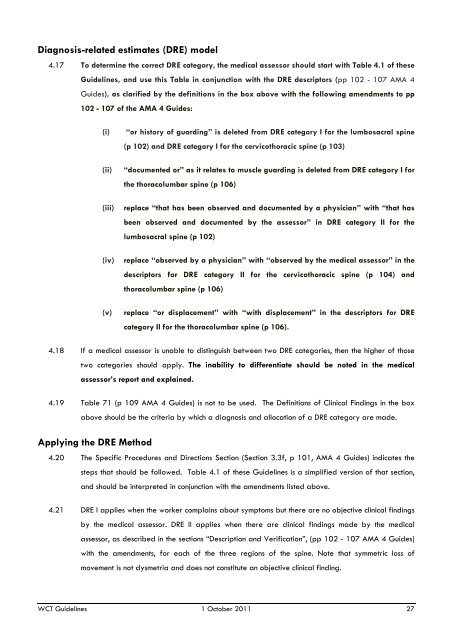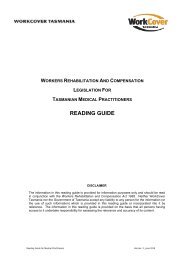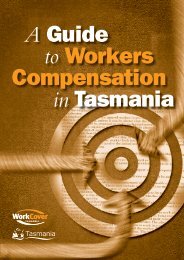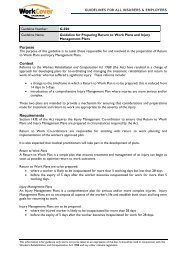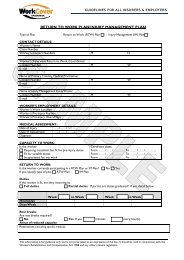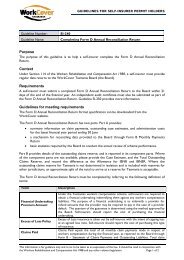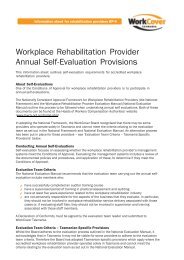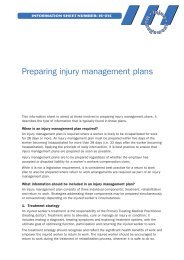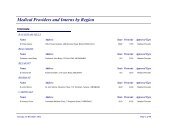Guidelines for the assessment of permanent impairment Version 3
Guidelines for the assessment of permanent impairment Version 3
Guidelines for the assessment of permanent impairment Version 3
Create successful ePaper yourself
Turn your PDF publications into a flip-book with our unique Google optimized e-Paper software.
Diagnosis-related estimates (DRE) model4.17 To determine <strong>the</strong> correct DRE category, <strong>the</strong> medical assessor should start with Table 4.1 <strong>of</strong> <strong>the</strong>se<strong>Guidelines</strong>, and use this Table in conjunction with <strong>the</strong> DRE descriptors (pp 102 - 107 AMA 4Guides), as clarified by <strong>the</strong> definitions in <strong>the</strong> box above with <strong>the</strong> following amendments to pp102 - 107 <strong>of</strong> <strong>the</strong> AMA 4 Guides:(i)(ii)(iii)(iv)(v)“or history <strong>of</strong> guarding” is deleted from DRE category I <strong>for</strong> <strong>the</strong> lumbosacral spine(p 102) and DRE category I <strong>for</strong> <strong>the</strong> cervicothoracic spine (p 103)“documented or” as it relates to muscle guarding is deleted from DRE category I <strong>for</strong><strong>the</strong> thoracolumbar spine (p 106)replace “that has been observed and documented by a physician” with “that hasbeen observed and documented by <strong>the</strong> assessor” in DRE category II <strong>for</strong> <strong>the</strong>lumbosacral spine (p 102)replace “observed by a physician” with “observed by <strong>the</strong> medical assessor” in <strong>the</strong>descriptors <strong>for</strong> DRE category II <strong>for</strong> <strong>the</strong> cervicothoracic spine (p 104) andthoracolumbar spine (p 106)replace “or displacement” with “with displacement” in <strong>the</strong> descriptors <strong>for</strong> DREcategory II <strong>for</strong> <strong>the</strong> thoracolumbar spine (p 106).4.18 If a medical assessor is unable to distinguish between two DRE categories, <strong>the</strong>n <strong>the</strong> higher <strong>of</strong> thosetwo categories should apply. The inability to differentiate should be noted in <strong>the</strong> medicalassessor’s report and explained.4.19 Table 71 (p 109 AMA 4 Guides) is not to be used. The Definitions <strong>of</strong> Clinical Findings in <strong>the</strong> boxabove should be <strong>the</strong> criteria by which a diagnosis and allocation <strong>of</strong> a DRE category are made.Applying <strong>the</strong> DRE Method4.20 The Specific Procedures and Directions Section (Section 3.3f, p 101, AMA 4 Guides) indicates <strong>the</strong>steps that should be followed. Table 4.1 <strong>of</strong> <strong>the</strong>se <strong>Guidelines</strong> is a simplified version <strong>of</strong> that section,and should be interpreted in conjunction with <strong>the</strong> amendments listed above.4.21 DRE I applies when <strong>the</strong> worker complains about symptoms but <strong>the</strong>re are no objective clinical findingsby <strong>the</strong> medical assessor. DRE II applies when <strong>the</strong>re are clinical findings made by <strong>the</strong> medicalassessor, as described in <strong>the</strong> sections “Description and Verification”, (pp 102 - 107 AMA 4 Guides)with <strong>the</strong> amendments, <strong>for</strong> each <strong>of</strong> <strong>the</strong> three regions <strong>of</strong> <strong>the</strong> spine. Note that symmetric loss <strong>of</strong>movement is not dysmetria and does not constitute an objective clinical finding.WCT <strong>Guidelines</strong> 1 October 2011 27


